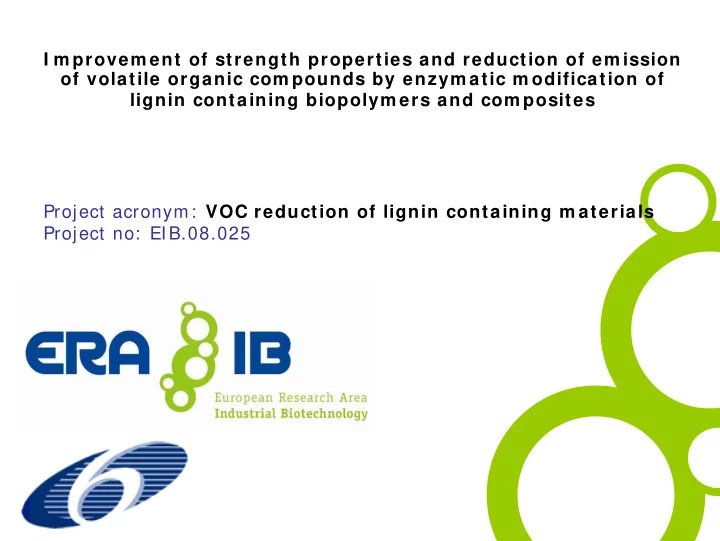

I m provem ent of strength properties and reduction of em ission of volatile organic com pounds by enzym atic m odification of lignin containing biopolym ers and com posites Project acronym: VOC reduction of lignin containing m aterials Project no: EIB.08.025
Project aim The project aims to develop new technologies to produce biopolymers from lignin materials. The state of art concerning bio-composite materials from lignin is characterised by high emission rate of volatile organic compounds (VOC) and unfavourable odour characteristics. The task of the project is the production of lignin-based biopolymers without unfavourable VOC emission by means of enzyme application. General project approach For this purpose different enzyme complexes will be developed with a specific spectrum of hemicellulases and lignin-oxidising activities for efficient degradation or polymerisation of lignin- and hemicellulose- based compounds, which are responsible for emissions of volatile organic compounds (VOC). Selected enzymes will be produced for application tests and incubation procedures of lignin and lignocellulose fibres. Investigations concentrate on the mechanisms of the enzymatically catalysed degradation and modification of the lignin and lignocellulose fibres.
Partner 1 , coordinator Prof. Dr. Christian Wilhelm Saxon Institute for Applied Biotechnology at the Leipzig University Leipzig, Germany E-mail: cwilhelm@rz.uni-leipzig.de Activity in the project The SIAB contributes to the fermentation and characterization of hemicellulase complexes using SIAB mutant strains and the fermentation of lignin-modifying enzym complexes produced from selected strains of the project partners from Spain and Belgium as well as the development of effective incubation processes of lignin and fibre substrate.
Partner 2 Prof. Dr. Maite Teresa Moreira University of Santiago de Compostela (USC), Dpt. of Chemical Engineering Santiago de Compostela, Spain E-mail: tmoreira@usc.es Activity in the project USC will develop lignin-modifying enzyme complexes composed of manganese and/ or versatile peroxidases with a high activity for the production of phenoxy radicals by partial lignin activation. The ligninolytic activities of enzymes obtained from several selected fungal strains will evaluated.
Partner 3 Prof. Dr. Michel Penninckx Université libre de Bruxelles (ULB), Microbial Physiology and Ecology Brussels, Belgium E-mail: mpenninc@ulb.ac.be Activity in the project The role of ULB is to select fungal strains from its own large strain collection, for efficient enzymatic modification of the raw material in order to reduce emission of volatile organic compounds and to modify physical properties of the lignin- material.
Partner 4 Dr.-Ing. Wolfgang Nendel Chemnitz University of Technology (TUC), Mechanical Engineering Chemnitz, Germany E-mail: Wolfgang.nendel@hrz.tu-chemnitz.de Activity in the project The TUC activities include investigation on effective compounding, extrusion and injection moulding processes and production of test samples and prototypes with modified and unmodified material.
Partner 5 Dr.-Ing. Alexander Pfriem Dresden University of Technology (TUD), Institute of Wood and Paper Technology Dresden, Germany E-mail: Alexander.Pfriem@tu-dresden.de Activity in the project The first activity of the TUD (IHP) will be the preparation of fibres and the determination of dynamic and viscoelastic properties and the long-time stability of the polymer samples; the second activity (IWPC) will be the quantification of VOC-emission of the substrate by thermal desorption in addition with chemical characterisation of lignin and lignocellulosic fibres before and after modification.
Partner 6 Prof. Dr. Ewa Dobrowolska Warsaw University of Life Sciences (SGGW), Faculty of Wood Technology Warszawa, Poland E-mail: Ewa_Dobrowolska@sggw.pl Activity in the project SGGW will assay the polymer samples made of modified and unmodified raw materials, esp. mechanical properties tests, surface hardness, surface wetting and energy, photo stability, density distribution profile and thermal properties.
Partner 7 Dr. Tarja Tamminen VTT - Technical research centre of Finland, Dpt. Processing of biomass components FIN-02044 VTT, Finland E-mail: tarja.tamminen@vtt.fi Activity in the project VTT activities will be the modification of lignin substrates, aiming at polymerisation and/ or depolymerisation by laccase-catalysed direct or indirect oxidation, using laccases from different origins and with different properties; polymerisation/ depolymerisation reactions will be studied and properties of the modified lignin will be analysed.
Partner 8 Dipl.-Ing. Emilia R. Inone-Kauffmann Fraunhofer Institute for Chemical Technology (ICT), Polymer Engineering Pfinztal, Germany E-mail: emilia.regina.inone@ict.fraunhofer.de Activity in the project ICT is responsible for lignin characterisation by near infrared spectroscopy, compound preparation, lab-scale direct injection moulding, in/ on-line control.
Objectives of the project are : • investigations on the mechanism of the enzymatic catalysed degradation and modification of the VOC- emission relevant compounds of lignins and carbohydrates using selected substrates with varying pre-treatments, • the development and production of special lignin- modifying enzymes and hemicellulases for the application, • the development of effective processes for the incubation of lignin and lignocellulose fibres, • the development of effective injection moulding processes with modified biopolymer materials, • the development of a new fibre-reinforced biopolymer material with reduced VOC emission and improved physical properties and its use for commercial products.
Expected results: • Specific enzyme complexes of phenol-oxidising enzymes and hemicellulases, • Deeper knowledge about the mechanism of enzymatic lignin modification, • Optimised incubation procedures, • New fibre-reinforced biopolymer with reduced VOC emission and improved physical properties
Solid state fermentation of white rot fungal strains
Recommend
More recommend